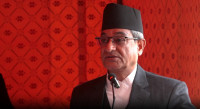National
Kathmandu starts getting Melamchi water again
The second-phase plan is to divert water from Yangri and Larke rivers to Melamchi to increase supply to the Valley.
Prithvi Man Shrestha
The Kathmandu Upatyaka Khanepani Limited has resumed distributing drinking water from the Melamchi Water Supply Project to the Valley’s households, starting from Anamnagar and Minbhawan areas.
Melamchi water is arriving in Kathmandu after a seven-month interruption. The project had stopped supplying water in June 2023 citing potential damage to its tunnel from monsoon floods.
The project’s headworks have been submerged in flood debris since June 2021, when torrents of water struck it just when the ‘national pride project’, 23 years in the making, was nearly complete. Since then, the project has been delivering water in the Valley through a temporary structure for certain months in a year.
Prime Minister Pushpa Kamal Dahal on Monday inaugurated the resumption of water supply in the Valley by allowing water to stream out from a traditional crocodile spout at Singha Durbar, the central secretariat of the government.
The Kathmandu Upatyaka Khanepani Limited (KUKL) said that distribution of the water would be gradually expanded to other parts of the Valley.
“We have started distributing water from storage tanks in Anamnagar and Minbhawan,” said Gyanendra Bahadur Karki, chief executive officer of KUKL. “The distribution of water will be expanded along with increased supply of water at the Sundarijal-based water treatment plant.”
According to him, as much as 50 million litres of water was supplied to Sundarijal-based treatment plant on Monday, up from 30 million litres on Sunday.
The project can supply up to 170 millions litres a day. But Karki said the Melamchi project is expected to supply 150 million litres a day at Sundarijal within a week under the current arrangement.
“The KUKL has also been distributing water at the rate of 100 million litres a day with existing structures other than those of Melamchi,” Karki said.
According to the KUKL, estimated daily demand for drinking water in Kathmandu Valley stands at 4-4.3 million litres based on the assumption that a person consumes an estimated 130 litres a day.
“But people are not consuming that much water a day at the moment,” Karki said. “That’s why, with the availability of water from the Melamchi project, Kathmandu residents should not face water scarcity.”
But when Kathmandu residents will get the supply of Melamchi water round-the-year is uncertain.
Prime Minister Dahal on Monday said that round-the-year supply of water from the project is currently not possible because of the compulsion to save the 27-km tunnel from being damaged during the monsoon.
As the river brings debris during monsoon, water cannot be diverted to the tunnel.
Prime Minister Dahal, however, said that the government has prioritised sustainable water supply from the project to the Valley.
But officials at the Melamchi Water Supply Board are not sure when the first phase of the project’s reconstruction will be completed, given that the existing headworks sustained considerable damage in the 2021 flooding.
In 2021, the debris brought by the massive floods had submerged the headworks.
A damage assessment report prepared by the Asian Development Bank (ADB), the main lender to the project, has suggested relocating the headworks to an area with a lower risk of devastating disasters.
“The government has sought the opinion of a group of experts associated with the Institute of Engineering on the relocation of headworks,” said Zakki Ahmad Ansari, executive director of the Melamchi Water Supply Development Board.
According to him, the ADB has suggested that new headworks be built 500-600 metres above the current location and a 900-metre-long tunnel be extended up to the site of the new headworks.
“The government will have to decide once the experts give their opinion on whether to relocate the headworks,” said Ansari. “Then fresh tender should be called to build new headworks.”
Based on current estimates, around Rs4 billion will have to be spent to build the headworks at the new location, according to Ansari.
Once the headworks are built and 170 million water is supplied to the Kathmandu Valley a day, the government has plans to start the second phase of the project. Under the second phase, water from Yangri and Larke rivers will be diverted to Melamchi to increase the supply to the Kathmandu Valley.
During Monday's event, Prime Minister Dahal said the government would take ahead the task of diverting water from these two rivers with an action plan.
According to the board, Yangri and Larke rivers, both of which are upstream of Melamchi, would add 170 million litres a day each.
Prime Minister Dahal said another treatment plant would be built at Sundarijal to purify more water. “A new distribution system and dirty water treatment system will also be built in Kathmandu,” he said.




 7.12°C Kathmandu
7.12°C Kathmandu















